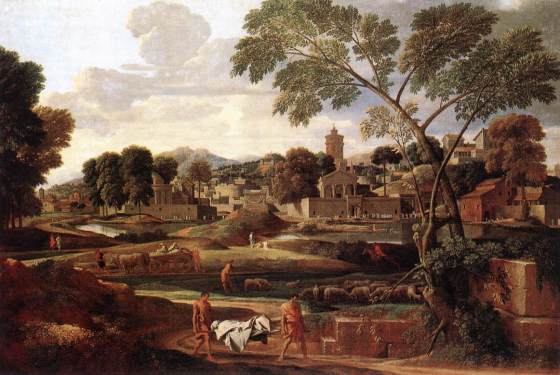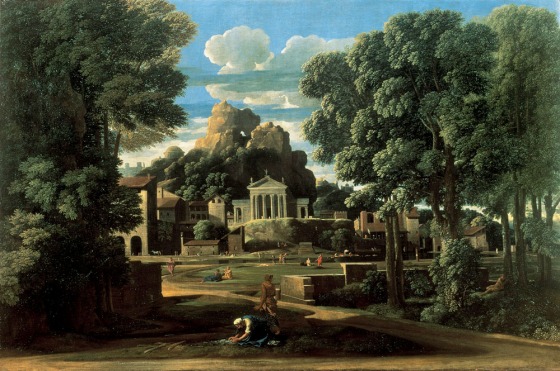In this Magnum Opus series, I will be discussing why certain pieces of art attain a “masterpiece” or “work of genius” status. Why do people flock to specific artworks in museums? Why are the same paintings always referenced in Art History 101 textbooks? Why do we still care about something that was created hundreds, if not thousands, of years ago? How universal is this “masterpiece” concept? Do all cultures make value judgements about their art? Why do some pieces become instant classics while it takes others years after the artist’s death to reach the same status?
Every so often I will choose a work of art to highlight in this series. Today’s selection is Nicolas Poussin’s two Phocion Paintings!


It is impossible to dissociate these two great landscapes by Poussin, one of which depicts the funeral of the Greek general Phocion, and the other of which portrays his widow gathering the ashes after his cremation. It seems to be that no previous painter had tackled these two subjects together, which were inspired by a text from Plutarch’s Parallel Lives (late 1st century C.E.). Poussin was 54 years old when he painted these two images, by which time he was permanently based in Rome with a formidable reputation. These works marked a change in the French artist’s style of painting as he moved away from historical narrative and developed a new approach to landscape. Unlike the works of his Flemish contemporaries, his landscapes were heroic rather than rustic. In their solemn grandeur they framed stories from classical and biblical sources and established a relationship between man and nature.
Phocion, a victorious Athenian general of the 4th century B.C.E., was known for the austerity of his politics and became unpopular among his fellow citizens. Accused of serious crimes, he was condemned to death and forced to drink hemlock. His enemies ordered that his body should be banished and carried out of the Attic region. We can see this subject being depicted in the Cardiff painting. Taken to Megara, the body of Phocion was burned and the ashes gathered by his widow and a female servant, as seen in the Walker Art Gallery painting. Phocion’s wife took his ashes to Athens with the hope that the Athenians would admit their mistake and restore the general’s reputation, which they soon did, recognizing that, “they had put to death he who had upheld justice and honesty in Athens.”
This story is all good and well, but is it essential to know the subjects in order to admire these paintings? Is it necessary to have read Plutarch? Should we question Poussin’s interpretation of the text? What were the artist’s intentions? What was he trying to tell us, and how’s he able to using only brushstrokes? Admittedly, Poussin had set the bar high for himself.
In the foreground of the first work, two men are carrying a stretcher. A white shroud covers the body of Phocion. The two stretcher-bearers are leaving Athens and have their backs to the city. In the middle ground, a shepherd is watching his sheep. Further away we see an ox cart. A horseman and some passers-by go about their daily business, indifferent to the events in the foreground. On the right, a tall tree grows up beside stone blocks with sharp edges. To the left are an embankment, more trees, and two lakes, one of which reflects the tree trunks. In the far distance are mountains under a huge morning sky. Some austere buildings, a tomb, a temple, and a tower inspired by the architecture of Palladio, punctuate the scene. In the distance, in front of the portico of a basilica, a long procession can be seen — Phocion was put to death on March 19, a day on which Athenians held a procession in honour of Zeus.
The second painting shows the town of Megara. As in the first picture, the road and the passers-by, set at varying distances, occupy the central section of the composition. In the background we see a woman playing the flute, a group of archers with their target, and some bathers, one of whom has taken off his shirt and is preparing to dive. Nature — the trees dotted around the landscape, the large rocks in the centre under a cloudy blue sky — fills most of the canvas. Alone in the foreground, standing out against the shadow of the tall trees, the two women are defying the proclamation and gathering the ashes of the hero, thus ensuring his passage to the afterlife. The servant has turned around for fear of being watched, and Phocion’s widow is bent humbly over the ashes that she is gathering with her hands.
The two pictures cleverly combine the countryside and the city. Was Poussin simply content to paint landscapes, as many as other painters in Rome at the time — Claude Lorrain, Gaspard Dughet, Salvator Rosa, and Pietro da Cortona — were? Or was he trying to depict something more specific, an idealized and sublime version of nature, luxuriant and constantly renewed, a calm and timeless nature, lush with vegetation, amid which the funeral rites of the hero unfold to general indifference? In these two works, the eternal and idealized qualities of the natural world are seen in opposition to the lowly condition of man and the insignificance of his fleeting existence.
One by one, each detail is crafted and takes on its own meaning. There is human ingratitude, the drama of adversity and injustice; there is compassion, faithfulness, and piety; there is a meditation on human destiny and a moral message; and there is the great and immutable spectacle of the natural world, which dwarfs all human actions. Above all, there is the ambition of the artist, who transforms what he sees into a meditation on the fragile existence of humanity and our place in nature. Man passes on, nature abides.
When Bernini came to Paris in 1665 on the express request of Louis XIV, he wished to visit collectors who owned works by Poussin. The greatest architect and sculptor of his century was then at the peak of his powers, and had long been an admirer of the painter’s oeuvre. Bernini visited the home of Sérizier, a Lyon silk-maker, who owned both Phocion paintings. He gazed at the images for a long time, and then, tapping his own forehead, exclaimed, “Signor Poussin is a painter who works from here.“
Excellent posting, Nicholas Poussin was an artist who I had to study in my 2nd or 3rd year of my art History Degree at the OU . It was the Arcadian Shepherds a very interesting painting by Poussin. Poussin was one of the greatest History Painters under Charles Lebrun’s French academy It easily outshone the British History Painters, His Mythological paintings are superb using light perspective foreshortening and able to show all aspects, including the Picture plane , the Linear perspective and Poussin’s Vanishing point. I intend shortly to write about French History painting.
Laurence
LikeLike